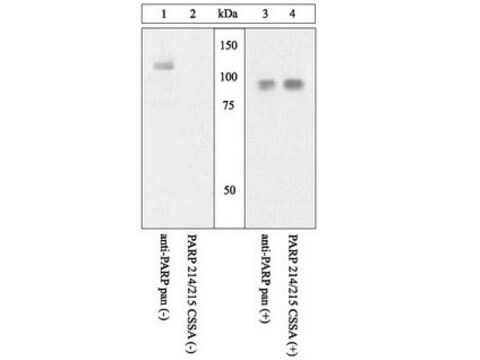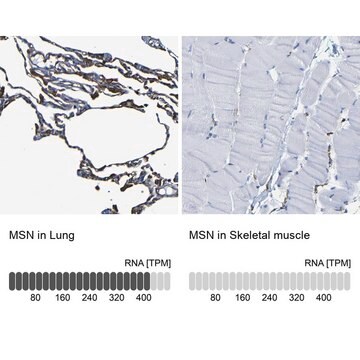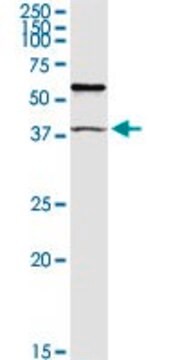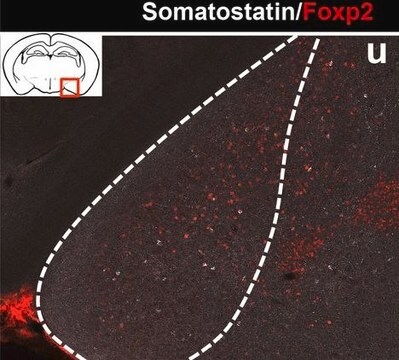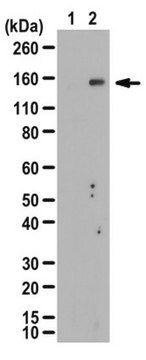推荐产品
一般說明
The protein named Proteinase-activated receptor 1 (PAR-1/PAR1) or Coagulation factor II receptor, or Thrombin receptor and encoded by the human gene F2R/CR2R/PAR1/TR is a high affinity receptor for activated thrombin and part of the innate immune system response driven by proteinase-activated receptors (PARs). PARs are G protein-coupled receptors that transmit cellular responses to extracellular proteases and have important functions in vascular physiology, development, inflammation, and cancer progression. PAR1 is important for platelet activation and vascular development. PAR1 expression is limited to platelets and vascular endothelial cells and is localized to the cell membrane. Interestingly too, even the signal peptide of PAR1 (which guides the protein to the membrane) plays a role in cell signaling as if forms the intracellular angiogenesis inhibitor peptide Parstatin.
免疫原
Linear peptide corresponding to human Par-1.
應用
Flow Cytometry Analysis: 4 µg from a representative lot detected Par-1 in 1X10E6 human thrombocytes (platelets).
Flow Cytometry Analysis: A representative lot from an independent laboratory detected Par-1 in CHRF-288 and HEL cells (Hoxie, J. A., et al. (1993). J Biol Chem. 268(18):13756-13763.).
Western Blotting Analysis: A representative lot from an independent laboratory detected Par-1 in human platelet membrane cell lysate (Brass, L. F., et al. (1992). J Biol Chem. 267(20):13795-13798.).
Immunocytochemistry Analysis: A representative lot from an independent laboratory detected Par-1 in CHRF-288 and HEL cells (Hoxie, J. A., et al. (1993). J Biol Chem. 268(18):13756-13763.).
Immunofluorescence Analysis: A representative lot from an independent laboratory detected Par-1 in CHRF-288 cells (Brass, L. F., et al. (1994). J Biol Chem. 269(4):2943-2952.).
Flow Cytometry Analysis: A representative lot from an independent laboratory detected Par-1 in CHRF-288 and HEL cells (Hoxie, J. A., et al. (1993). J Biol Chem. 268(18):13756-13763.).
Western Blotting Analysis: A representative lot from an independent laboratory detected Par-1 in human platelet membrane cell lysate (Brass, L. F., et al. (1992). J Biol Chem. 267(20):13795-13798.).
Immunocytochemistry Analysis: A representative lot from an independent laboratory detected Par-1 in CHRF-288 and HEL cells (Hoxie, J. A., et al. (1993). J Biol Chem. 268(18):13756-13763.).
Immunofluorescence Analysis: A representative lot from an independent laboratory detected Par-1 in CHRF-288 cells (Brass, L. F., et al. (1994). J Biol Chem. 269(4):2943-2952.).
This Anti-PAR-1 antibody, clone ATAP2 is validated for use in western blotting, flow cytometry, ICC & immunofluorescence for the detection of PAR-1.
品質
Evaluated by Western Blotting in mouse lymph node tissue.
Western Blotting Analysis: 1 µg/mL of this antibody detected Par-1 in 10 µg of mouse lymph node tissue.
Western Blotting Analysis: 1 µg/mL of this antibody detected Par-1 in 10 µg of mouse lymph node tissue.
標靶描述
~50 kDa observed. Uncharacterized band(s) may be observed in some cell lysates.
外觀
Format: Purified
其他說明
Concentration: Please refer to the Certificate of Analysis for the lot-specific concentration.
未找到合适的产品?
试试我们的产品选型工具.
儲存類別代碼
12 - Non Combustible Liquids
水污染物質分類(WGK)
WGK 1
閃點(°F)
Not applicable
閃點(°C)
Not applicable
Internalization and recycling of activated thrombin receptors.
Hoxie, J A, et al.
The Journal of Biological Chemistry, 268, 13756-13763 (1993)
L F Brass et al.
The Journal of biological chemistry, 269(4), 2943-2952 (1994-01-28)
According to current models, human thrombin receptors are activated when thrombin cleaves the receptor's N terminus, exposing the tethered ligand domain, SFLLRN. In the megakaryoblastic CHRF-288 cell line, thrombin receptor activation is followed by the rapid internalization of > 90%
L F Brass et al.
The Journal of biological chemistry, 267(20), 13795-13798 (1992-07-25)
Based upon its recently cloned nucleotide sequence, the human platelet thrombin receptor is thought to be formed by a single polypeptide chain with seven transmembrane domains and an extracellular N terminus that can be cleaved by thrombin. As yet, however
Xiaofeng Cai et al.
Journal of thrombosis and haemostasis : JTH, 17(5), 803-817 (2019-03-14)
Essentials APC elicits cytoprotective responses in endothelial cells via EPCR-dependent cleavage of PAR1. APC inhibits LPS-mediated translocation and extracellular secretion of HMGB1 in endothelial cells. Signaling activity of APC inhibits LPS-mediated acetylation of HMGB1 by epigenetic mechanisms. APC inhibits LPS-mediated
我们的科学家团队拥有各种研究领域经验,包括生命科学、材料科学、化学合成、色谱、分析及许多其他领域.
联系技术服务部门